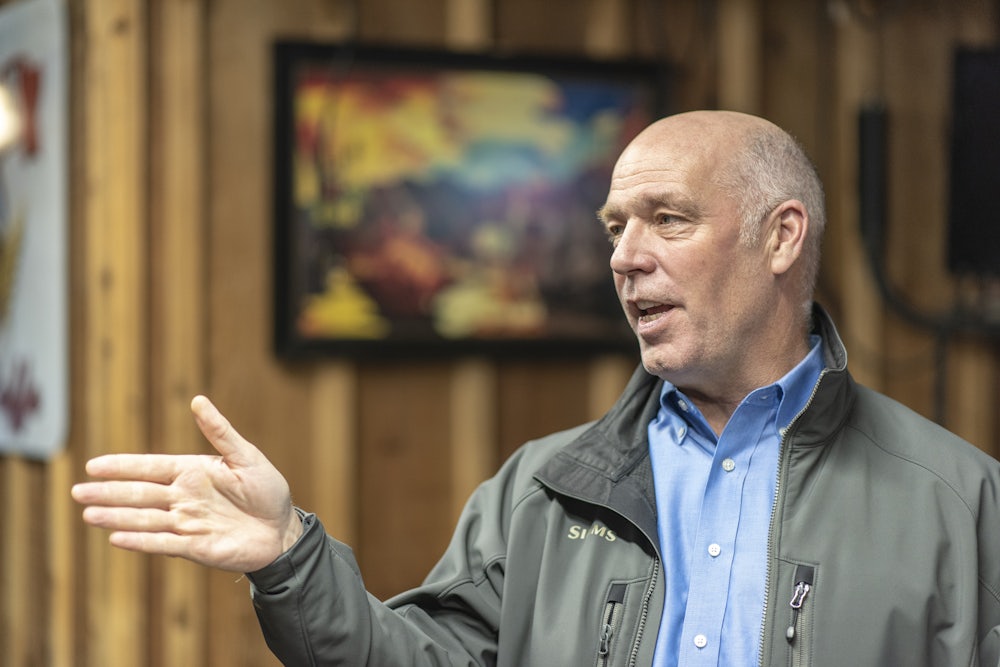A child tax credit proposal by the Republican governor of Montana has stalled in the state legislature, due in part to opposition from Democrats. Although Governor Greg Gianforte has said that he will keep pushing for the $1,200-per-child credit—a centerpiece of his budget proposal—the initial legislation failed to garner sufficient support to be approved as a stand-alone bill. Montana is one of several states to consider such a measure, after the pandemic-era expansion of the federal child tax credit expired at the end of 2021. But the episode includes a partisan twist, as several Democrats joined Republicans in stymieing the progress of Gianforte’s proposal.
Other provisions of Gianforte’s budget were approved by the legislature, including more than $1 billion in tax cuts and rebates for Montanans. But the child tax credit stalled due to resistance from some strange bedfellows: Conservative GOP lawmakers who opposed the proposal and Democrats who argued that Republicans had not given enough ground on their other priorities.
Gianforte’s proposal was relatively generous, offering taxpayers earning up to $50,000 each year a $1,200 credit per child under the age of 6. The original version of the bill, offered by Republican state Representative Josh Kassmier, included a key feature of the erstwhile federal expanded child tax credit: It would have been fully refundable—meaning that it would have been available to families with no earned income. The proposal would phase out, with households earning more than $56,000 annually unable to receive any portion of the credit.
“We’re really encouraged by this bill, because it does put the needs of families at the center,” said Caitlin Jensen, the executive director of Zero to Five Montana, a statewide advocacy organization focused on early childhood education and care.
The bill initially received widespread bipartisan support, mirroring the popularity of parent-focused tax credits statewide. According to an October poll commissioned by Zero to Five Montana and conducted by Montana State University, 74 percent of Montana voters agreed that tax credits for parents helped offset the cost of raising a child.
The bill overwhelmingly passed the House Taxation Committee and was approved in an initial floor vote, but the House Appropriations Committee tabled it in February. The measure needed support from Democrats to advance, but five of the seven Democrats on the committee voted to table the legislation, along with nine of 16 Republicans. The deadline to approve budget bills in the state House passed last week, meaning that the proposal will not be taken up before the end of the legislative session, although it could still be tacked onto another bill as an amendment.
“Nothing is dead until the legislature is done, and we still have time on the clock,” Gianforte said in a press conference last week, adding that he was “hopeful we can revive this child tax credit so we can get help to working families.”
Gianforte has framed the proposal as providing leeway for parents to afford childcare or other necessities. “We are such strong proponents of the child tax credit, which puts the money in the pockets of the parents to let them decide. Some will choose childcare, some will choose it as a mechanism to allow one of the spouses to stay home and be a caregiving parent,” Gianforte said last week.
There has been increased momentum for statewide child tax credit proposals since the federal child tax credit was significantly expanded by the American Rescue Plan, the nearly $2 trillion coronavirus relief package that passed in 2021. But that expansion expired in 2022, putting the onus on states to decide whether to implement similar policies. Studies have shown that most poor households spent the expanded federal child tax credit on necessities; a report from October 2021 found that 86 percent of low-income Montanans used that credit for basic needs and education.
The bill had also been amended to include a provision requiring proof of earned income to obtain the credit. There is a comparable requirement for the state earned income tax credit, which allows anyone to claim the credit if they have earned at least $1 that year.
Montana has been particularly affected by the crisis that has upended early childcare across the country, particularly in the wake of the Covid-19 pandemic. A 2021 report by the Montana Department of Labor and Industry found that the state’s total childcare capacity only meets 44 percent of the demand, and classified 60 percent of Montana’s counties as “child care deserts.” Another agency report found that Montana households averaged more than $16,000 in childcare expenses for children under age 5.
Given the high cost of childcare, the child tax credit proposal is not a universal panacea. “A $1,200 tax credit could help to put a dent in the cost of childcare, but it’s not everything,” said Jensen.
Around 68,000 Montanans cannot participate fully in the workforce—either working reduced hours or unable to work at all—due to family responsibilities and lack of childcare. Around 44 percent of Montanans live in rural areas, meaning that many parents may have fewer work opportunities than those in urban centers, said Jensen.
Democrats have contended that Gianforte was pushing the child tax credit as a solution to address childcare affordability and that it would allow the governor to wash his hands of any further action on Democratic priorities.
“If it came back without strings attached, I’d be for it, or I’d be a lot more for it,” Representative Emma Kerr-Carpenter, one of the Democrats on the Appropriations Committee who voted against the bill, told The Montana Free Press. “And also if I knew it wasn’t going to be used as some sort of shield to avoid doing other things for families.”
Democrats have also been critical of the $1 billion tax rebate and spending package that the governor signed in March—sans child tax credit proposal—arguing that its income tax cut would disproportionately benefit the wealthy. One analysis found that the wealthiest 1 percent of Montanans would receive $6,000 in tax cuts annually after the change, compared to just $70 for citizens near the median income.
Meanwhile, state House Democrats continue pushing for action on issues of housing, mental health, and childcare more broadly. “If people are expecting our votes to move priorities, even if we like them, we need our priorities funded too,” House Minority Leader Kim Abbott told reporters the day after the child tax credit bill was tabled. Democrats have supported a measure to expand a scholarship for childcare that has advanced in the state legislature, but say that Republicans have not done enough to tackle the issue; most Republicans have voted down the bills that Democrats have put forward. “Democrats have proposed solution after solution that would give relief, both in terms of tax—property tax and income tax—and in terms of access to childcare,” Abbott argued.
Jensen expressed hope that the proposal could still make it through the legislature, citing Gianforte’s own optimism and continued commitment to supporting the policy. “We just hope that bills or policies that are intended to really support Montana families aren’t bargaining chips in the larger spending discussions for our state,” Jensen said. “We realize this isn’t a cure-all to any of the childcare issues or bigger challenges in investing in our early childhood system. But it’s a really good start.”










